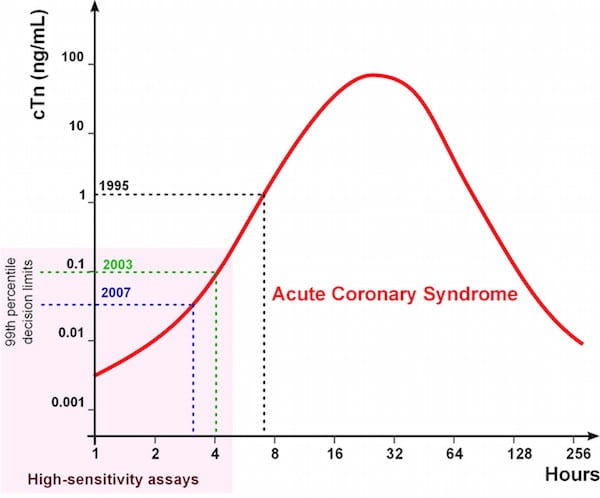Traditionally we’ve run at least 2 troponins 6 or 8 hours apart to help rule out MI and recently in algorithms like the HEART score we’ve combined clinical data with a 2 or 3 hour delta troponin to help rule out MI. The paper we’ll be discussing here is a recent multicentre/multinational study from the Canadian Medical Association Journal out of Switzerland entitled “Prospective validation of a 1 hour algorithm to rule out and rule in acute myocardial infarction using a high sensitivity cardiac troponin T assay” with lead author Tobias Reichlin. It not only looks at whether or not we can rule out MI using a delta troponin at only 1 hour, but whether or not we can expedite the ruling in of MI using this protocol.
Teresa Chan took a well deserved break from co-hosting this Journal Jam, and instead we have a special guest, the King of Critical Appraisal himself, the brains behind BEEM – Best Evidence in EM, Dr. Andrew Worster from McMaster University. Dr. Worster is a Professor in the Department of Medicine, Division of Emergency Medicine, and Associate Member, Dept of Clinical Epidemiology & Biostatistics, the Research Director, Emergency Medicine, Hamilton Health Sciences and a Staff Emergency Physician, Hamilton Health Sciences.
This is the start of a new collaborative effort for our upcoming series BEEM Cases, a blog with Justin Morgenstern (First10EM) and Rory Spiegel (EM Nerd) where important clinical questions answered by a series of articles are run through the BEEM critical appraisal team engine and then presented in an engaging educational blog on EM Cases. We’d love to hear your comments on One Hour Troponin to Rule In and Out MI below.
Published on December 22nd, 2015. Dr. Anton Helman
Cite this podcast as: Reichlin, T, Chan, T, Worster, A. One Hour Troponin to Rule Ot and In MI. Emergency Medicine Cases. December, 2015. https://emergencymedicinecases.com/one-hour-troponin/. Accessed [date].
References
Reichlin T, Twerenbold R, Wildi K, et al. Prospective validation of a 1-hour algorithm to rule-out and rule-in acute myocardial infarction using a high-sensitivity cardiac troponin T assay. CMAJ. 2015;187(8):E243-52.
Kavsak PA, Pardhan A, Krizmanich W, Worster A. Hospital Admission and Myocardial Injury Prevalence after the Clinical Introduction of a High-Sensitivity Cardiac Troponin I Assay. Clin Chem. 2015;61(9):1209-10.
Goodman DA, Kavsak PA, Hill SA, Worster A. Presenting characteristics of patients undergoing cardiac troponin measurements in the emergency department. CJEM. 2015;17(1):62-6.
James owen J, Worster A, Marie waines B, Ward J, Kavsak P, Hill S. Root cause analysis of delays to discharge for patients held for serial cardiac troponin levels. CJEM. 2014;16(1):20-4.
Backus BE, Six AJ, Kelder JC, et al. A prospective validation of the HEART score for chest pain patients at the emergency department. Int J Cardiol. 2013;168(3):2153-8.
Cullen L, Mueller C, Parsonage WA, et al. Validation of high-sensitivity troponin I in a 2-hour diagnostic strategy to assess 30-day outcomes in emergency department patients with possible acute coronary syndrome. J Am Coll Cardiol. 2013;62(14):1242-9.
Dr. Helman, Dr. Worster & Dr. Reichlin have no conflicts of interest to declare
Other FOAMed Resources on Troponin
Salim Rezaie on The HEART Score on R.E.B.E.L EM
Amul Matta on Low Risk Chest Pain on ER Cast





Thanx ,Dr Helman
It’s very useful,
As a medical student ,I am so so glad to find such discussion which make me more confident with the ttt of my patient .
Thank u again